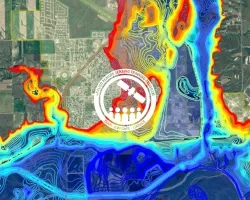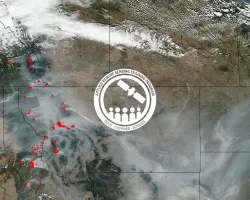Description
While carbon dioxide (CO2) is the primary greenhouse gas emitted through human activities, methane is estimated around 80 times more effective at trapping heat in the atmosphere on a 20 year timescale.
Methane is an attractive target for mitigation activities because it has a relatively short decadal-scale lifetime in the atmosphere (as compared with the century-scale carbon dioxide lifetime), it can be utilized as an energy source or combusted (converted to CO2) in order to reduce its global warming potential, and the safety issues associated with high concentrations of this flammable gas. Many activities can lead to the release of large concentrations of methane during the course of normal industrial operations or as accidental releases, these are often referred to as super emitter events, which can be identified from modern satellites.
This introductory two-part training will begin with an introduction to the U.S. Greenhouse Gas Center and provide participants with an overview of how methane observations from the Earth surface Mineral dust Source Investigation (EMIT) mission can be used to identify and monitor areas of high methane enhancement. This course will also demonstrate how to navigate the U.S. Greenhouse Gas center portal to access data products as well as highlight tools for visualizing methane observations.
This training is also available in Spanish.
- Fundamentals of Remote Sensing
- Participants should create a NASA Earthdata account prior to the start of the training by visiting the Earthdata Login sign up page.
By the end of this training attendees will be able to:
- Identify the goals and objectives of the U.S. Greenhouse Gas Center
- Define the roles of methane and large emission events in climate change
- Identify the sensors used to measure methane
- Recognize the strengths and limitations of satellite observations used to measure methane for large emission event tracking
- Navigate the U.S. Greenhouse Gas Center Portal and the EMIT Open Data Portal to access and visualize data for large emission event tracking
Federal, state and local government agency representatives, United Nations agencies with policy mandates related to GHG emission measurement, monitoring and mitigation (e.g., UNEP), entities whose operations produce methane (i.e. oil and gas sector, landfills, livestock, etc.), as well as non-public sector entities with roles/responsibilities in providing GHG data, solutions and services.
University students, early career researchers, and the media may also be interested.
- Two, 90 minute parts
- Each part includes a 30-min Q&A session
- Recognize the role of methane in the Earth system
- Identify the goals and objectives of the U.S. Greenhouse Gas Center
- Identify sensors used to measure atmospheric methane
Materials:
- Recognize the strengths and limitations of satellite observations of methane used to observe large emission events
- Navigate the U.S. Greenhouse Gas Center Portal to access and visualize data for large emission event tracking and the EMIT Open Data Portal to understand observation context
Materials:
- Presentation Slides
- Q&A Transcript
- Homework (Due December 5)



